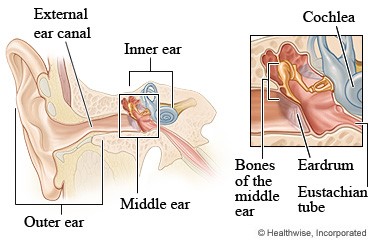Hearing Loss in Children with Down Syndrome
What you need to know

Hearing loss is common in children with Down syndrome and can affect development.
Both conductive hearing loss and sensorineural hearing loss can occur with Down syndrome.
Conductive hearing loss
- This type of hearing loss is the most common in children with Down syndrome. Conductive hearing loss is usually temporary, but can sometimes be permanent.
- This hearing loss occurs because sound waves have difficulty travelling through the outer and middle ear to reach the cochlea (inner ear). If the outer ear is blocked due to wax, or if the middle ear is blocked due to fluid or infection, sound waves will be softer than normal when they reach the cochlea.
- If your child has conductive hearing loss, ear tubes are sometimes recommended.
Sensorineural hearing loss
- This type of hearing loss is less common. It is permanent. Children with Down syndrome have some risk for developing sensorineural hearing loss.
- This hearing loss happens because of changes in the inner ear. Sometimes the inner ear is not sending sound messages to the brain. Other times, the auditory nerve, which carries sound messages to the brain, is not working.
- If your child has sensorineural hearing loss, hearing aids may be recommended.
When should my child’s hearing be tested?
Children with Down syndrome should have newborn hearing screening done, followed by a diagnostic Auditory Brainstem Response (ABR) test before 6 months of age.
If there are no hearing concerns, children with Down syndrome should then have regular hearing tests 1 time every year from age 18 months to 5 years.
If there are hearing concerns, your child will be referred to an ear, nose, and throat specialist (called an otolaryngologist or ENT). They will also have their hearing checked more often.
What causes conductive hearing loss?
The majority of hearing loss associated with Down syndrome is conductive hearing loss. This is because of:
- narrow and small ear canals
- serous otitis media (fluid in the middle ear)
- wax blockage
- eustachian tube problems
What treatments are available?
Talk with your doctor about the treatments that are available for your child’s conductive hearing loss. Some options may include:
- wax removal by a doctor
- ear tubes
- antibiotics
If these treatments don’t resolve the hearing loss, talk with your audiologist about hearing aids or other assistive listening devices that make speech and sounds louder.
What can I do to help my child’s listening?
To help improve your child’s listening and understanding:
- Have your child look at the person who is speaking.
- Get your child’s attention before speaking.
- Minimize background noise.
- Speak clearly with a strong voice that is easy to hear.
To see this information online and learn more, visit https://MyHealth.Alberta.ca/health/aftercareinformation/pages/conditions.aspx?hwid=custom.ab_hearing_loss_ds_child_inst.

For 24/7 nurse advice and general health information call Health Link at 811.
Current as of: May 16, 2023
Author: Audiology Provincial Professional Practice, Alberta Health Services
This material is not a substitute for the advice of a qualified health professional. This material is intended for general information only and is provided on an "as is", "where is" basis. Although reasonable efforts were made to confirm the accuracy of the information, Alberta Health Services does not make any representation or warranty, express, implied or statutory, as to the accuracy, reliability, completeness, applicability or fitness for a particular purpose of such information. Alberta Health Services expressly disclaims all liability for the use of these materials, and for any claims, actions, demands or suits arising from such use.
